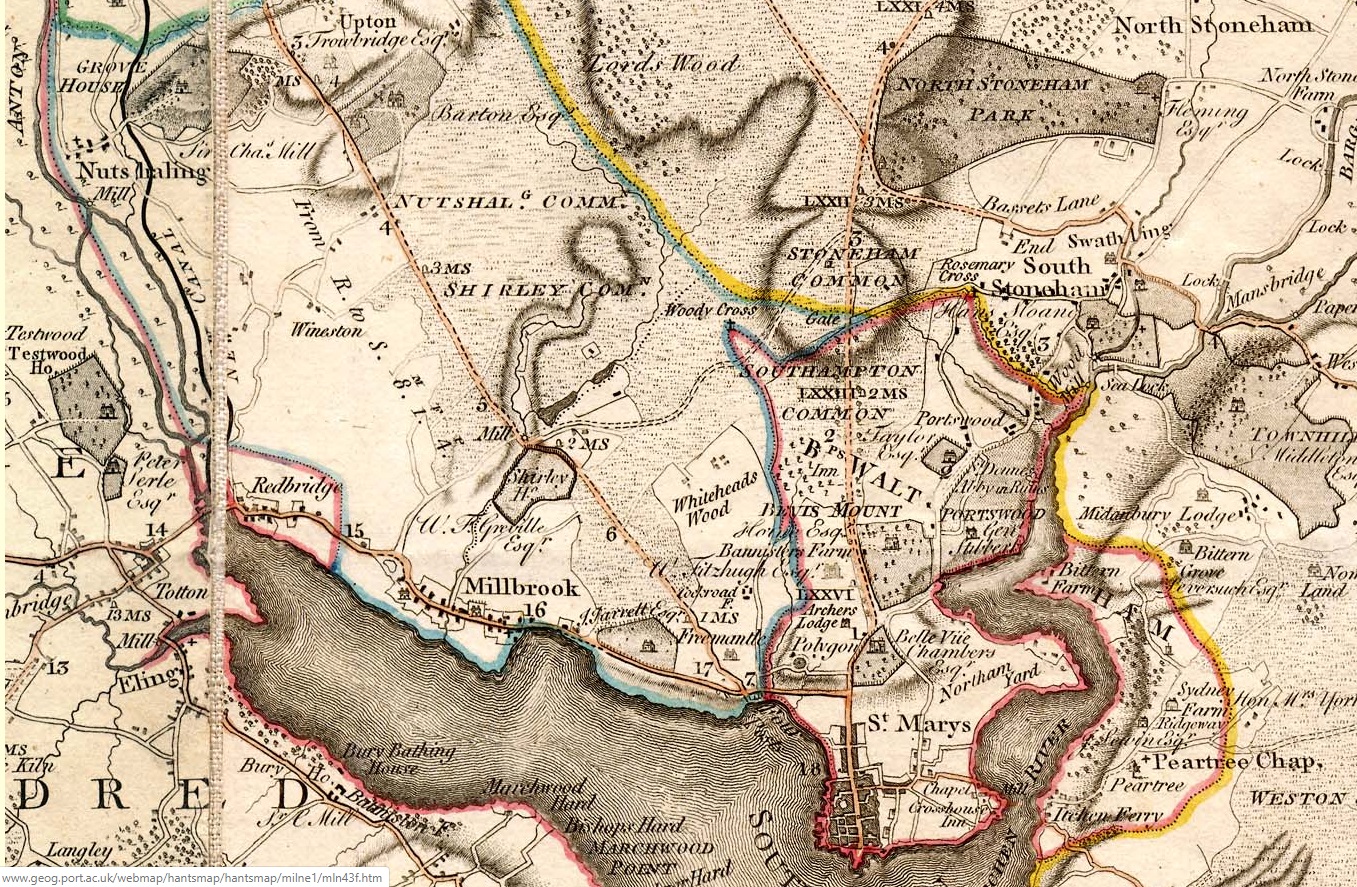Shirley, Hampshire
Shirley was at one time part of the parish of Milbrook, having previously been a Parish in its own right, but dissolved and incorporated into Millbrook in
However as a manor it has stood on its own, as described in British History Online. An extract below. As a manor, it was also known as Shirley and Hill. The Hill village was at the bottom of the current Hill Lane, near Four Posts, and was part of the Hill and Sidford Tithing.
In the reign of Edward the Confessor Cheping held SHIRLEY (Sirelei, xi cent.; Schyrlegh and Shirlee, xiii cent.) of the king, and it was assessed at 1 hide. Ralph de Mortimer held in Cheping's stead at the time of the Domesday Survey, (fn. 17) and his descendants held knights' fees in Shirley as late at least as 1362. (fn. 18) By the fifteenth century, however, the manor had come to be looked upon as held of the prior and convent of St. Denis, (fn. 19) which held much property in the neighbourhood. In the fourteenth century the manor was held by the family of Shirley. Nicholas de Shirley in 1240 granted the advowson of the church of Shirley, which up to this time had no doubt gone with the manor, to the prior of St. Denis, (fn. 20) and Isabel de Shirley, widow of Roger de Shirley, and Nicholas, Roger, John, and Simon, sons of Roger de Shirley, were also benefactors to the priory. (fn. 21)
In 1272 Nicholas son of Roger, who was no doubt son of Roger de Shirley, granted two parts of a messuage, a mill, and other appurtenances in Shirley to Nicholas de Barbflete or Barnflete and Alice his wife. (fn. 22) Nicholas was a member of a family coming originally from Barfleur which had long been settled at Southampton. (fn. 23) In 1286 he was appointed by the king to collect the murage at Southampton and to apply the same towards rebuilding Southampton Castle. (fn. 24) Four years later licence was given him to grant a spring in his manor of Shirley to the Friars Minor of Southampton, (fn. 25) while in 1327 the friars received licence to make a conduit underground from this spring in Shirley, called Colewell, as far as Houndewellecrouche, and thence by King Street to their dwelling house, to lay the pipes of the conduit in such part of the street as they should find most suitable, and to repair the same as often as required. (fn. 26) Nicholas de Barbflete died seised of the manor of Shirley in 1294 leaving a son and heir Nicholas. (fn. 27) The latter died before 1311 (fn. 28) and was succeeded by Richard de Barbflete, (fn. 29) probably his son, who was mayor of Southampton in 1317. (fn. 30) In 1327 Maud widow of Richard released all right in Shirley and Hill to Roger Normand and Joan his wife, (fn. 31) to whom free warren within the manor was granted ten years later. (fn. 32) Roger was a wealthy merchant (fn. 33) and one of the most prominent burgesses of Southampton at this time, being M.P. for the town in 1328, 1332, and 1338–9 and mayor in 1330. (fn. 34) He stood high in favour with Edward III, who in 1337 appointed him to man a ship called La Coggersshippe to take engines and other weapons to Scotland, (fn. 35) and in 1338 exempted him from further service in consideration of his having for no small time found at his own charges divers ships of war and armed men both on land and sea in defence of the realm against foreign attack. (fn. 36) He also assisted so largely in the building of the church of Holy Rood or St. Cross, Southampton, that in 1333 by decision of John bishop of Winchester permission was granted to him to be interred within it. (fn. 37) Roger died seised of the manor in 1349 leaving his grandson Giles, a minor, his heir. (fn. 38) The custody of the manor was committed to John Inkpen during the minority of Giles, (fn. 39) but the latter died in 1362 leaving as his heir his cousin Margaret, wife of John Chamberlayne. (fn. 40) It is difficult to trace the descendants of Margaret and John, but they seem to have had a daughter and heiress Alice who became the wife of Richard Beket. Hence in 1391 the charter of Edward III granting free warren in his demesne lands in Shirley to Roger Normand was confirmed to Richard Beket and Alice his wife, kinswoman and heir of Roger Normand. (fn. 41) By 1433 the manor had descended to a certain Joan wife of Robert Peny, who in that year in conjunction with her husband quitclaimed it to Robert Whitehead. (fn. 42) From Robert it seems to have passed to John Whitehead, who settled it in fee-tail upon his son Maurice and Joan his wife. Maurice died seised in 1496–7 leaving a son and heir John, aged nine; (fn. 43) but it is doubtful whether the latter succeeded to his inheritance, for George Whitehead died seised in 1520 leaving a son and heir, a minor, John, (fn. 44) whose guardianship was committed to Sir William Sandys. (fn. 45) Evidently John died without issue either during his minority or soon after he had entered into possession since his brother Augustine died seised of the manor in 1557–8 assigning it as part dower of his wife Julian. (fn. 46) His son Richard died seised of the reversion in May 1593, and on the death of Julian four months later the manor passed to Henry, son and heir of Richard. (fn. 47)
Follow the above link for the footnotes.
more later
